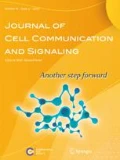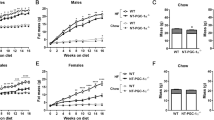Abstract
IGFBP-2 affects growth and metabolism and is thought to impact on energy homeostasis and the accretion of body fat via its heparin binding domains (HBD). In order to assess the function of the HBD present in the linker domain (HBD1) we have generated transgenic mice overexpressing mutant human IGFBP-2 lacking the PKKLRP sequence and carrying a PNNLAP sequence instead. Transgenic mice expressed high amounts of human IGFBP-2, while endogenous IGFBP-2 or IGF-I serum concentrations were not affected. In both genders we performed a longitudinal analysis of growth and metabolism including at least 4 separate time points between the age of 10 and 52 weeks. Body composition was assessed by nuclear magnetic resonance (NMR) analysis. Food intake was recorded by an automated online-monitoring. We describe negative effects of mutant human IGFBP-2 on body weight, longitudinal growth and lean body mass (p < 0.05). Very clearly, negative effects of mutant IGFBP-2 were not observed for fat mass accretion throughout life. Instead, relative fat mass was increased in transgenic mice of both genders (p < 0.05). In male mice transgene expression significantly increased absolute mass of total body fat over all age groups (p < 0.05). Food intake was increased in female but decreased in male transgenic mice at an age of 11 weeks. Thus our study clearly provides gender- and time-specific effects of HBD1-deficient hIGFBP-2 (H1d-BP-2) on fat mass accretion and food intake. While our data are in principal agreement with current knowledge on the role of HB-domains for fat accretion we now may also speculate on a role of HBD1 for the control of eating behavior.









Similar content being viewed by others
References
Arai T, Busby W Jr, Clemmons DR (1996) Binding of insulin-like growth factor (IGF) I or II to IGF-binding protein-2 enables it to bind to heparin and extracellular matrix. Endocrinology 137:4571–4575
Asarian L, Geary N (2013) Sex differences in the physiology of eating. Am J Physiol Regul Integr Comp Physiol 305:R1215–R1267
Boudry C, Dehoux JP, Colinet FG, Wavreille J, Portetelle D, Beckers Y, Théwis A (2010) Effect of bovine colostrum on the serum insulin-like growth factor-I (IGF-I), the IGF binding proteins-2 and −3 and the thyroid hormones in weaning piglets. Archiv Tierzucht 53:675–688
Choleris E, Cazzin L, Lymer JM, Amor TR, Lu R, Kavaliers M, Valsecchi P (2013) Acute corticosterone sexually dimorphically facilitates social learning and inhibits feeding in mice. Neuropharmacology 75:191–200
Davis KE, Carstens EJ, Irani BG, Gent LM, Hahner LM, Clegg DJ (2014) Sexually dimorphic role of G protein-coupled estrogen receptor (GPER) in modulating energy homeostasis. Horm Behav 66:196–207
DeMambro VE, Clemmons DR, Horton LG, Bouxsein ML, Wood TL, Beamer WG, Canalis E, Rosen CJ (2008) Gender-specific changes in bone turnover and skeletal architecture in igfbp-2-null mice. Endocrinology 149:2051–2061
DeMambro VE, Maile L, Wai C, Kawai M, Cascella T, Rosen CJ, Clemmons D (2012) Insulin-like growth factor-binding protein-2 is required for osteoclast differentiation. J Bone Miner Res 27:390–400
Eckstein F, Pavicic T, Nedbal S, Schmidt C, Wehr U, Rambeck W, Wolf E, Hoeflich A (2002) Insulin-like growth factor-binding protein-2 (IGFBP-2) overexpression negatively regulates bone size and mass, but not density, in the absence and presence of growth hormone/IGF-I excess in transgenic mice. Anat Embryol (Berl) 206:139–148
Foulstone EJ, Zeng L, Perks CM, Holly JM (2013) Insulin-like growth factor binding protein 2 (IGFBP-2) promotes growth and survival of breast epithelial cells: novel regulation of the estrogen receptor. Endocrinology 154:1780–1793
Hedbacker K, Birsoy K, Wysocki RW, Asilmaz E, Ahima RS, Farooqi IS, Friedman JM (2010) Antidiabetic effects of IGFBP2, a leptin-regulated gene. Cell Metab 11:11–22
Hoeflich A (2008) Contrasting bone effects of temporary versus permanent IGFBP administration in rodents. Growth Horm IGF Res 18:181–187
Hoeflich A, Wu M, Mohan S, Foll J, Wanke R, Froehlich T, Arnold GJ, Lahm H, Kolb HJ, Wolf E (1999) Overexpression of insulin-like growth factor-binding protein-2 in transgenic mice reduces postnatal body weight gain. Endocrinology 140:5488–5496
Hoeflich A, Nedbal S, Blum WF, Erhard M, Lahm H, Brem G, Kolb HJ, Wanke R, Wolf E (2001) Growth inhibition in giant growth hormone transgenic mice by overexpression of insulin-like growth factor-binding protein-2. Endocrinology 142:1889–1898
Hoeflich A, Wirthgen E, David R, Classen CF, Spitschak M, and Brenmoehl J (2014). Control of IGFBP-2 Expression by Steroids and Peptide Hormones in Vertebrates. Front Endocrinol. (Lausanne) 5: 43
Khosla S (2008) Insulin-like growth factor binding protein-2: a novel regulator of skeletal gender differences? Endocrinology 149:2048–2050
Kratzsch J, Blum WF, Schenker E, Keller E, Jahreis G, Haustein B, Ventz M, Rotzsch W (1993) Measurement of insulin-like growth factor I (IGF-I) in normal adults, patients with liver cirrhosis and acromegaly: experience with a new competitive enzyme immunoassay. Exp Clin Endocrinol 101:144–149
Kuang Z, Yao S, Keizer DW, Wang CC, Bach LA, Forbes BE, Wallace JC, Norton RS (2006) Structure, dynamics and heparin binding of the C-terminal domain of insulin-like growth factor-binding protein-2 (IGFBP-2). J Mol Biol 364:690–704
Munoz-Gutierrez M, Findlay PA, Adam CL, Wax G, Campbell BK, Kendall NR, Khalid M, Forsberg M, Scaramuzzi RJ (2005) The ovarian expression of mRNAs for aromatase, IGF-I receptor, IGF-binding protein-2, −4 and −5, leptin and leptin receptor in cycling ewes after three days of leptin infusion. Reproduction 130:869–881
Rehfeldt C, Renne U, Sawitzky M, Binder G, Hoeflich A (2010) Increased fat mass, decreased myofiber size, and a shift to glycolytic muscle metabolism in adolescent male transgenic mice overexpressing IGFBP-2. Am J Physiol Endocrinol Metab 299:E287–E298
Russo VC, Bach LA, Fosang AJ, Baker NL, Werther GA (1997) Insulin-like growth factor binding protein-2 binds to cell surface proteoglycans in the rat brain olfactory bulb. Endocrinology 138:4858–4867
Russo VC, Schütt BS, Andaloro E, Ymer SI, Hoeflich A, Fosang AJ, Ranke MB, Bach LA, and Werther GA (2004). Proteoglycan complexes in the rat brain olfactory bulb. Proceedings 12th International congress of Endocrinology
Russo VC, Schutt BS, Andaloro E, Ymer SI, Hoeflich A, Ranke MB, Bach LA, Werther GA (2005) Insulin-like growth factor binding protein-2 binding to extracellular matrix plays a critical role in neuroblastoma cell proliferation, migration, and invasion. Endocrinology 146:4445–4455
Sartorius T, Peter A, Schulz N, Drescher A, Bergheim I, Machann J, Schick F, Siegel-Axel D, Schurmann A, Weigert C, Haring HU, Hennige AM (2014) Cinnamon extract improves insulin sensitivity in the brain and lowers liver fat in mouse models of obesity. PLoS One 9:e92358
SAS Institute Inc. 2013. Base SAS® 9.4 Procedures Guide, Second Edition. Cary, NC: SAS Institute Inc.)
SAS Institute Inc. 2013. SAS/STAT® 13.1 User’s Guide. Cary, NC: SAS Institute Inc.)
Shen X, Xi G, Maile LA, Wai C, Rosen CJ, Clemmons DR (2012) Insulin-like growth factor (IGF) binding protein 2 functions coordinately with receptor protein tyrosine phosphatase beta and the IGF-I receptor to regulate IGF-I-stimulated signaling. Mol Cell Biol 32:4116–4130
Wheatcroft SB, Kearney MT (2009) IGF-dependent and IGF-independent actions of IGF-binding protein-1 and −2: implications for metabolic homeostasis. Trends Endocrinol Metab 20:153–162
Wheatcroft SB, Kearney MT, Shah AM, Ezzat VA, Miell JR, Modo M, Williams SC, Cawthorn WP, Medina-Gomez G, Vidal-Puig A, Sethi JK, Crossey PA (2007) IGF-binding protein-2 protects against the development of obesity and insulin resistance. Diabetes 56:285–294
Xi G, Solum MA, Wai C, Maile LA, Rosen CJ, Clemmons DR (2013) The heparin-binding domains of IGFBP-2 mediate its inhibitory effect on preadipocyte differentiation and fat development in male mice. Endocrinology 154:4146–4157
Xi G, Wai C, DeMambro V, Rosen CJ, and Clemmons DR (2014). IGFBP-2 Directly Stimulates Osteoblast Differentiation. J. Bone Miner. Res
Yau SW, Henry BA, Russo VC, McConell GK, Clarke IJ, Werther GA, Sabin MA (2014) Leptin enhances insulin sensitivity by direct and sympathetic nervous system regulation of muscle IGFBP-2 expression: evidence from nonrodent models. Endocrinology 155:2133–2143
Acknowledgments
We are grateful to Tamara Holy and Eckhard Wolf (Gene Center, Munich, Germany) for microinjection of the transgenic expression vector and development of the H1d-BP2 mouse model. VCR was supported by the NHMRC of Australia (Project Grant, # 1008062). AH was supported by the Deutsche Forschungsgemeinschaft (DFG HO2003/1-6).
Author information
Authors and Affiliations
Corresponding author
Rights and permissions
About this article
Cite this article
Wiedmer, P., Schwarz, F., Große, B. et al. Gender-specific effects on food intake but no inhibition of age-related fat accretion in transgenic mice overexpressing human IGFBP-2 lacking the Cardin-Weintraub sequence motif. J. Cell Commun. Signal. 9, 143–150 (2015). https://doi.org/10.1007/s12079-015-0264-z
Received:
Accepted:
Published:
Issue Date:
DOI: https://doi.org/10.1007/s12079-015-0264-z




